Osame Sahraoui (170cm/5’7”), is a right-footed playmaker who joined the academy of Norwegian side, Vålerenga, in 2014. He’s risen well up the ranks of the five-time Eliteserien champions since then and made his first-team debut for the club in the 2020 season, in which he scored five goals and made 10 assists, helping his side to a third-place finish — their best league finish since they managed second place in 2009.
To the surprise of no one, Sahraoui’s involvement in the first-team picture has continued this year, and he has scored two goals and made six assists in Eliteserien this term. The Vålerenga academy product also made his debut for Norway’s U21s this year, and in his four appearances for them thus far, he’s made a good impression by scoring one goal and making two assists.
At 20 years of age, Sahraoui is a malleable player; he’s played a lot on both wings thus far in his career but primarily from the left, from where he often likes to cut inside onto his stronger right foot and create from the half-space. He’s played as a ‘10’ at times too, but this season he’s primarily been used as a left-sided ‘8’ in Dag-Eilev Fagermo’s 4-3-3 (4-1-2-3) system. I’ll analyse the creator’s style of play, strengths and potential areas of improvement with a focus on his performances in these different roles within his team’s strategy and tactics, as I progress through this tactical analysis and scout report.
This scout report looks to shine a light on why I believe Sahraoui is one of the most exciting talents in Norway at the moment, as well as perhaps being one of the main youngsters of note currently operating outside of Europe’s top-five leagues. The 20-year-old (valued at €600k by Transfermarkt) is at a vital stage of his career in terms of his development and based on what he’s been showing for Vålerenga, I think he could be ready to take a step up in level of competition, though that hypothetical move would have to be carefully selected to make sure it’s the right one for the player to maximise his potential at this stage of his career. I hope to highlight what this playmaker could offer a team via this scout report to explain how and where he could be best used in the future. All data in this tactical analysis, unless otherwise stated, comes from Wyscout, and the match footage I’ve studied is from Wyscout.
Dribbling and progression
My tactical analysis is split into four distinct sections: ‘dribbling and progression’, ‘creative passing’, ‘shooting’, and ‘defensive work’. Firstly, I’ll focus on Sahraoui’s dribbling ability, which I also feel is his greatest asset. The Norway U21 international is simply a lovely player to watch on the ball. He demonstrates excellent ball control, quick and efficient footwork, as well as a lot of speed and agility on the ball to beat his opponents and/or carry the ball to progress his team upfield.
This season, Sahraoui has made 7.95 dribbles per 90, ranking him 9th among the 90 wingers / attacking midfielders / centre-forwards to have played at least 500 Eliteserien minutes this season, but with a good-not-great success rate of 55.84%. The Vålerenga playmaker has also made 4.04 progressive runs per 90 this term, which ranks him in 4th among the Eliteserien players in that same aforementioned list (per Wyscout: A run is considered progressive if the distance before the starting point and the last touch of the player is: 1. at least 30 meters closer to the opponent’s goal if the starting and finishing points are in their own half, 2. at least 15 meters closer to the opponent’s goal if the starting and finishing points are in different field halves, or 3. at least 10 meters closer to the opponent’s goal if the starting and finishing points are in the opponent’s half).
With this, we can see that Sahraoui is a high-volume dribbler with a decent success rate, as well as being a great asset for his side in terms of ball progression. This may be a key reason as to why he’s played a lot of games as an ‘8’ this term. His ability to drive his side upfield is useful from this position; Sahraoui tends to drop deep to receive the ball from his centre-backs in the build-up or progression phases with the team’s aim being to get the 20-year-old on the ball with a chance to move forward. As well as his impressive speed, agility, and technical ability, confidence, bravery, and comfortability with playing in deeper areas are important attributes for Sahraoui to possess to make successful progressive runs, and it’s maybe in these mental attributes (and frequency of scanning) where I think he can make the most improvement.
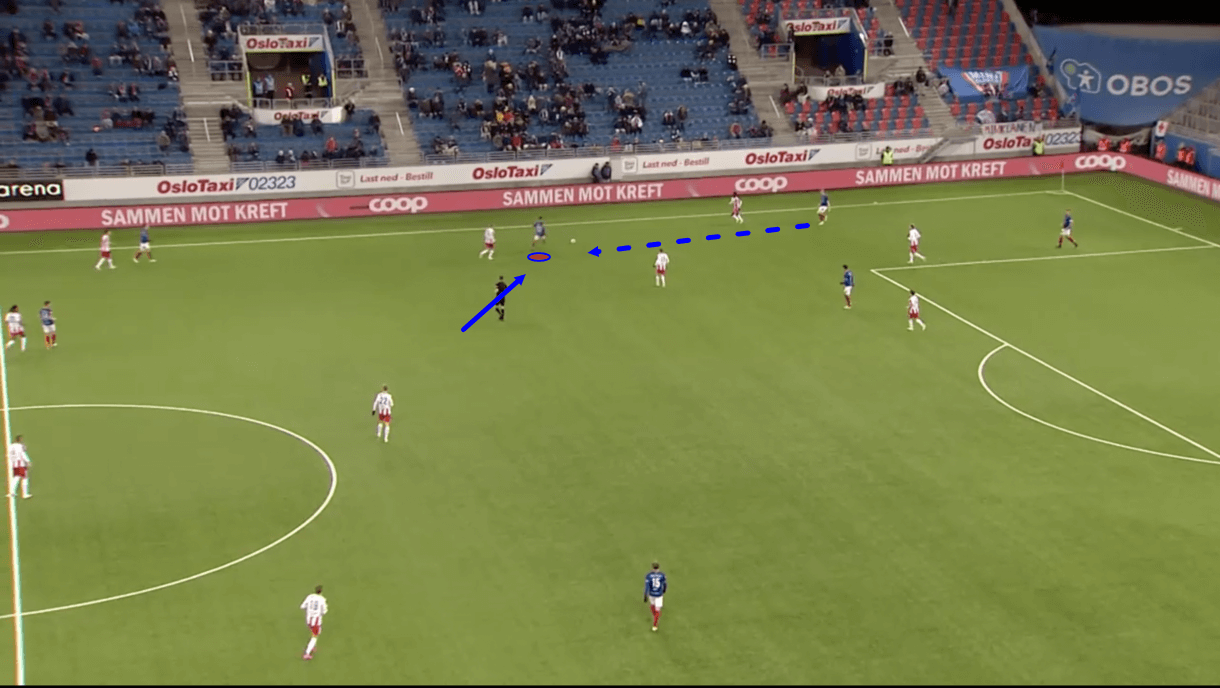
It’s common to see Sahraoui in situations like the one we see in figure 1, where the midfielder has dropped deep to give the full-back an option out wide. Evidently, he vacated the centre of the pitch to do this, putting himself in the wide channel, but with just one opposition player nearby and some space between him and that opposition player, this isn’t a bad scenario for Sahraoui as I think he could feasibly turn and take the defender on 1v1 here.
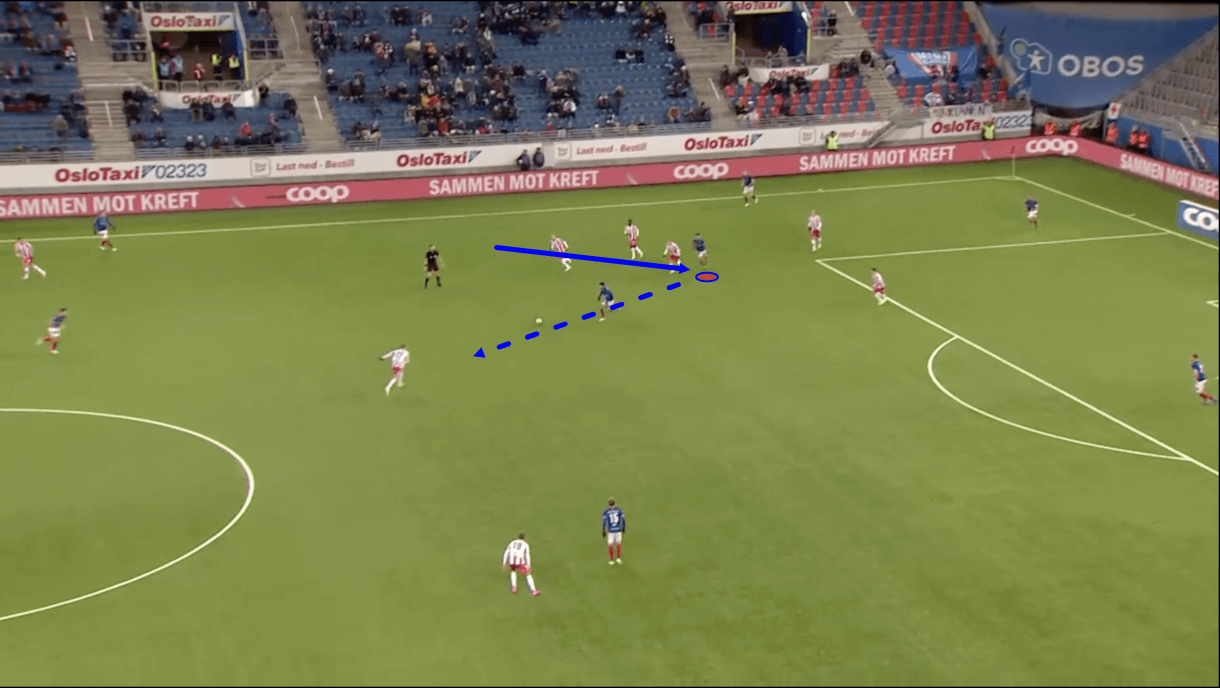
However, instead of doing that, Sahraoui opts to carry the ball backwards, choosing to attract more opposition pressure and create space for a teammate before trying to release them. This isn’t a bad idea but as we can see from figure 2, the amount of pressure Sahraoui drew upon himself made life more difficult and he was forced to play the forward pass while turning, which led to decreased accuracy. The pass ultimately created a 50/50 between Sahraoui’s intended target and an opposition defender in central midfield and could easily have led to a very dangerous opposition counter-attack, so this example doesn’t provide the most glowing example of Sahraoui’s ability as a central midfielder, particularly in these deeper areas.
However, the reason I use this example is that I think the Norwegian playmaker has the technical and physical abilities to avoid such situations more than he does, through increased scanning to improve his spatial awareness and a boost in the mental attributes of bravery and confidence in his own ability. He’s a very quick and agile dribbler who excels in 1v1s, and he should use this where necessary, with figure 1 arguably providing an example of where it might’ve been necessary.
It’s very common to see Sahraoui receive the ball while facing his own goal inside his own half but arrive on the ball with a heavy touch to move closer to his own goal. I think he’d do well to work on welcoming the ball a bit more softly on certain occasions to give himself a better chance of turning more quickly.
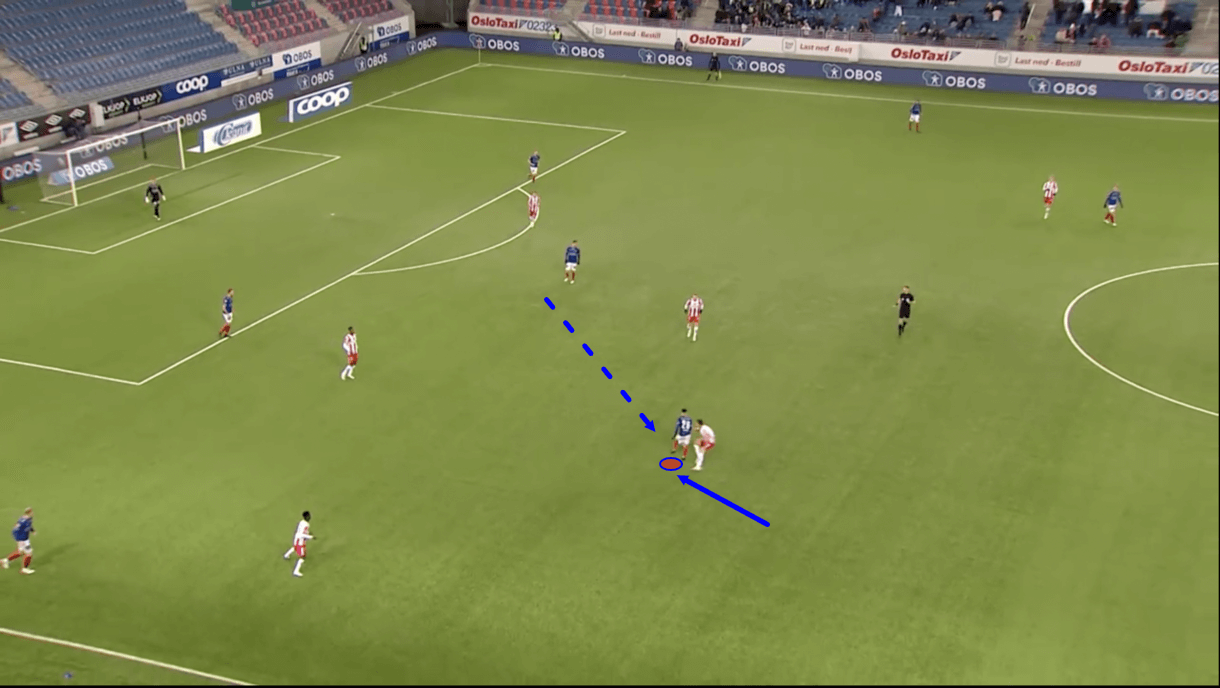
Figure 3 shows an example of an occasion when Sahraoui backed himself to turn while under pressure inside his own half — a similar scenario to the one we saw in figure 1. On this occasion, he’s positioned even more centrally and the defender behind him is even tighter to him, while the 20-year-old has just received a pass from the holding midfielder.

Despite these arguably even more difficult conditions, as we see in figure 4, Sahraoui managed to create enough space for his agility to come into action and turn to face the opposition’s goal. He managed to turn quickly and effectively, as his quick feet and impressive ball control combined with his agility to help him take the ball past the defender on his tail. From here, Sahraoui could progress his side upfield. This example highlights the benefit of Sahraoui in these deep positions, as he’s capable of being very press resistant and a great asset in ball progression, especially via his progressive carries.
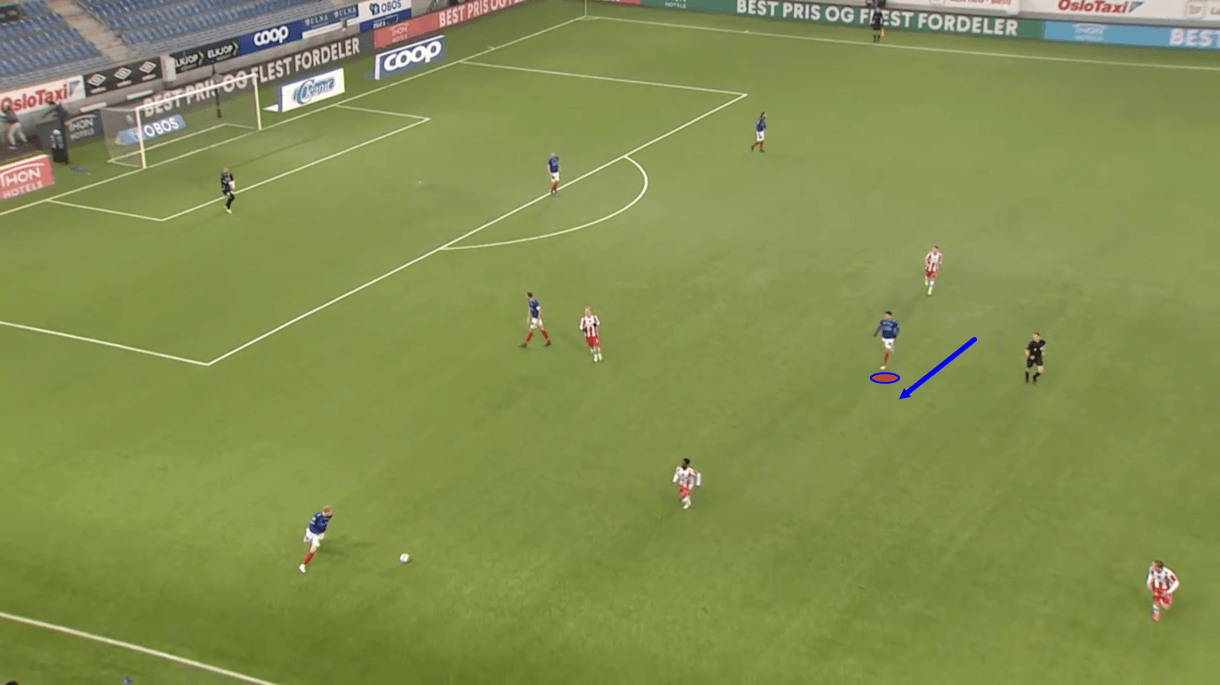
Figure 5 shares another example of Sahraoui occupying a deep, central position while Vålerenga’s right-back is on the ball, assessing his options. As play moves on from this image, the right-back opts to send the ball into Sahraoui’s feet, with the midfielder then tasked with continuing his side’s progression. Sahraoui’s play could’ve been a bit quicker here, however, which may show another example of where higher frequency scanning would help. Between this image and when he receives the ball, we don’t see the midfielder check his shoulders, which didn’t result in him getting dispossessed but may have led to some slightly slower decision-making than if he’d scanned before receiving the ball.
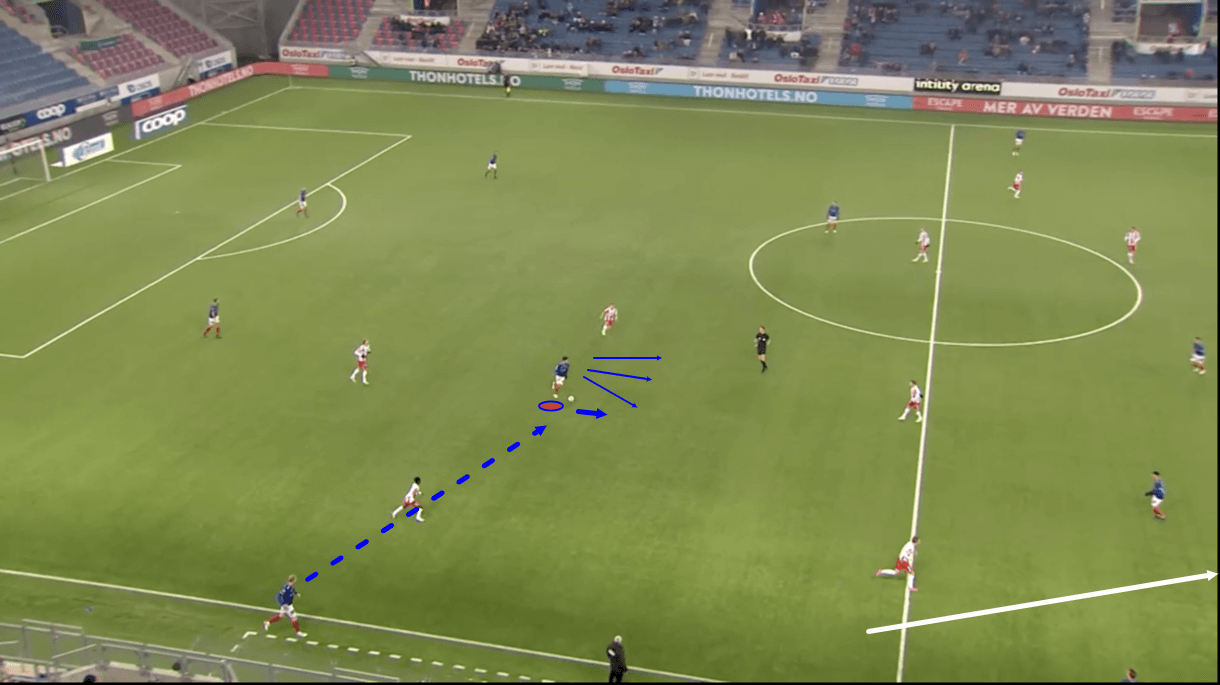
As Sahraoui receives the ball in figure 6, now we see him surveying the options ahead of him. However, had he scanned before this, it’s possible he’d have done some of this work already and would be better prepared to make a decision and execute his pass. We’re talking a second or two of time here but that could’ve been helpful in playing a pass, for instance, to the player in the right half-space before the opposition’s left wing-back (seen retreating here) got back into his base defensive position, to exploit the opposition’s more unsettled structure. Additionally, this extra time he’s now spending on the ball allows the opposition player over his left shoulder to pressure him.
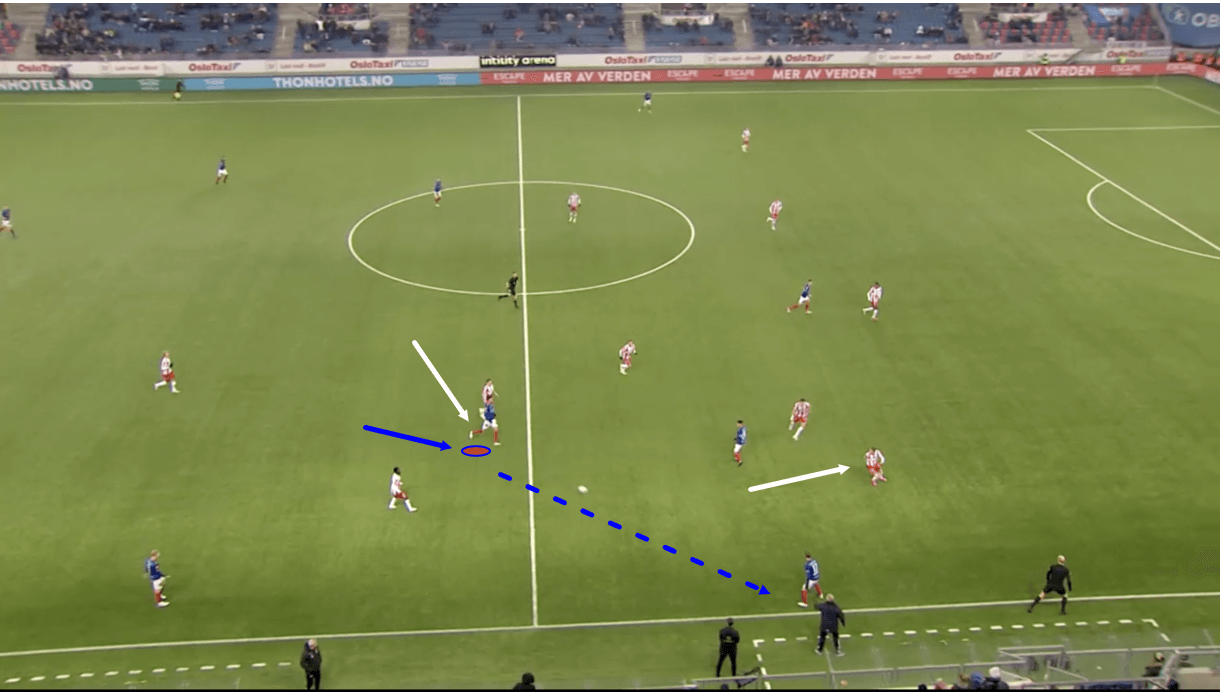
As play moves on into figure 7, we see that with the opposition’s defensive structure more settled and now under pressure, Sahraoui ends up playing a pass out to the right-winger, who immediately comes under pressure from the wing-back (now well-positioned) and as play moves on from here, the receiver ends up making his next action under pressure and ultimately loses the ball. There’s no way of knowing if a quicker decision would have resulted in a better outcome for Vålerenga, but it could’ve put his team in a better position to succeed with this attack, so for all of his strengths as a progressor and a creator, some increased scanning and quicker decision-making could help Sahraoui to improve.
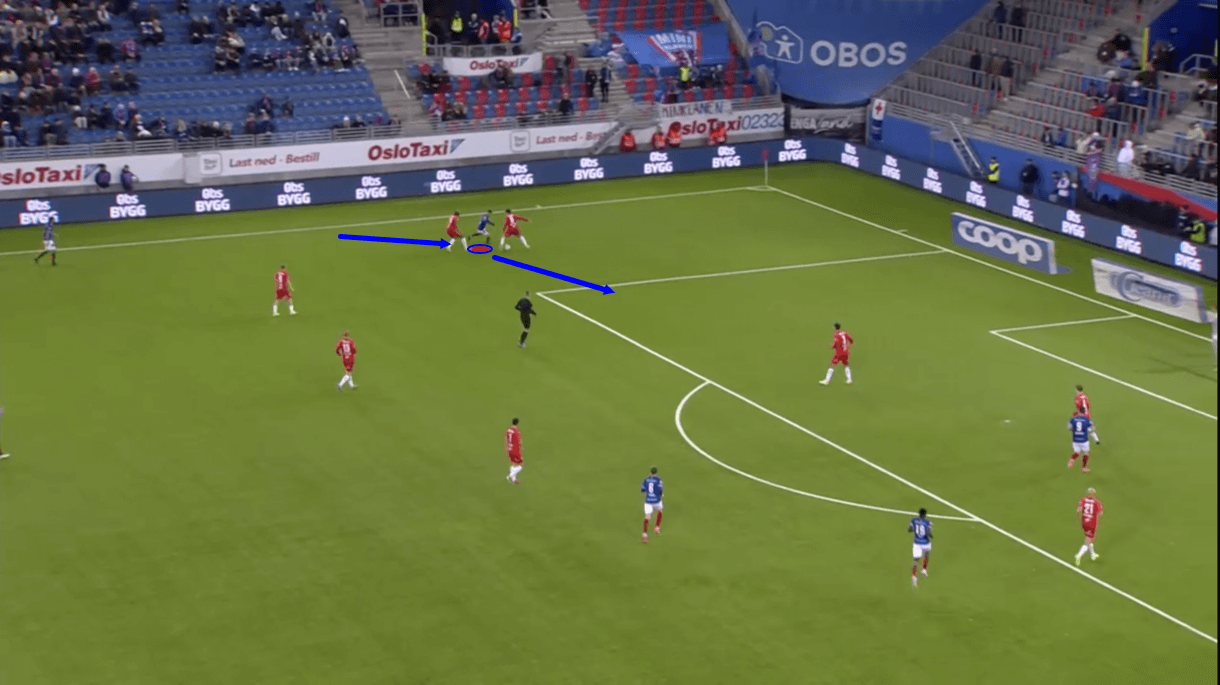
As mentioned earlier, though, Sahraoui often plays as a winger — particularly a left-winger; from this position, he loves to cut inside onto his stronger right foot. He also loves to cut inside onto his left foot from the right-wing when played there, however, and though this is his weaker foot, he’s comfortable playing and creating off of it; it’s a relatively strong ‘weaker’ foot. His dribbling ability (in terms of technical and physical quality) helps him to achieve success when drifting inside from the wing. Figure 8 shows an example of Sahraoui cutting inside onto his stronger right-foot from the left-wing. He had two opposition players doubling up on him to prevent him from progressing here, but their efforts were in vain as Sahraoui successfully found a gap between them where he could flick the ball and follow it through himself — exercising his excellent speed and agility, as well as ball control.
As play moves on from here, we see the playmaker get into the box. From here, he often likes to set up crossing opportunities, which was the case on this occasion but is also happy to shoot which we see him do plenty of the time as well.
There are countless examples of play like this from Sahraoui over the past two years. He’s a really difficult dribbler to stop; even if defenders are aware of his intentions, they tend to struggle to prevent him from executing them thanks to his technical and physical qualities. Sahraoui is capable of keeping the ball close while moving past defenders. You’ll often see him setting off on mazy runs between multiple opposition players and coming out on top. With his dribbling ability, he’s capable of taking several opposition players out of the game, both in more open spaces in deeper areas and in tighter spaces more advanced upfield. As a dribbler, there aren’t many, if any, better in Norway right now.
Creative passing
Sahraoui doesn’t just possess great dribbling ability — he also has excellent ability as a creative passer in the final third, which will be the focus of my next section of analysis. The Vålerenga man is more willing to take risks further up the pitch, such as in figure 8, than in deeper areas of the pitch, and this is true for his passing as well as his dribbling. Sahraoui is an excellent asset for breaking the opposition’s backline in one way or another. He’s capable of weaving through defenders and carrying the ball through the defensive line, while he’s also capable of exploiting the smallest gaps in the opposition’s defensive line with his incisive passing to set up a killer blow.
The playmaker’s four assists place him joint-13th in Eliteserien among wingers, attacking midfielders and strikers to have played at least 500 minutes in 2021, but he’s managed to generate 5.22 xA (7th on that list) with his creative passing this season, indicating that the quality of chances he’s set up may have been even better than his solid assists numbers indicate.
‘A smart pass’ is defined by Wyscout as ‘a creative and penetrative pass that attempts to break the opposition’s defensive lines to gain a significant advantage in attack’ — it’s something that you typically want your creative players to be doing in the chance creation phase and this season, Sahraoui has played more smart passes (2.66 per 90) than any other Eliteserien player. He’s managed to retain a 45.45% smart pass accuracy from his 2.66 per 90 as well, which is decent considering the high volume of smart passes he’s played. Sahraoui has also played 2.78 through passes per 90 in 2021 — the third-most of any Eliteserien winger, attacking midfielder, and striker with 500 or more minutes to their name this term.
All of this tells us a lot about what kind of player Sahraoui is — he’s a great asset in the chance creation phase when playing just in front of the opposition’s last line, who thrives with offensive runners ahead of him.
As we know, he’s sometimes required to play in deeper areas too and he’s capable as a progressive passer from deep, playing 5.53 progressive passes per 90 this season (13th among wingers, attacking midfielders and forwards with 500 or more minutes) with a solid 81.75% progressive pass accuracy. In general, regardless of his exact role or position in a game, Sahraoui loves to be heavily involved, receive the ball to feet regularly and take the game into his own hands to try and open the opposition up. However, I think, at present, Sahraoui is far more comfortable operating high up the pitch, in the final third and being most heavily involved in the chance creation phase, rather than dropping deep to be more of a progressor.

Figures 9 and 10 show our first example of an in-game passage of play in which Sahraoui demonstrates his defence-splitting creative passing ability. As mentioned in the previous section, Sahraoui often plays on the wings and when he does so, often starts out wide, holding the width for his side, where he can receive the ball before then looking to carry it inside and create from a more threatening central position. Just before figure 9, Sahraoui (playing on the right-wing here) offered some support to a teammate out wide and was chosen as a passing option. As he received the ball, he turned inwards and started carrying it centrally, from where he generally prefers to create.
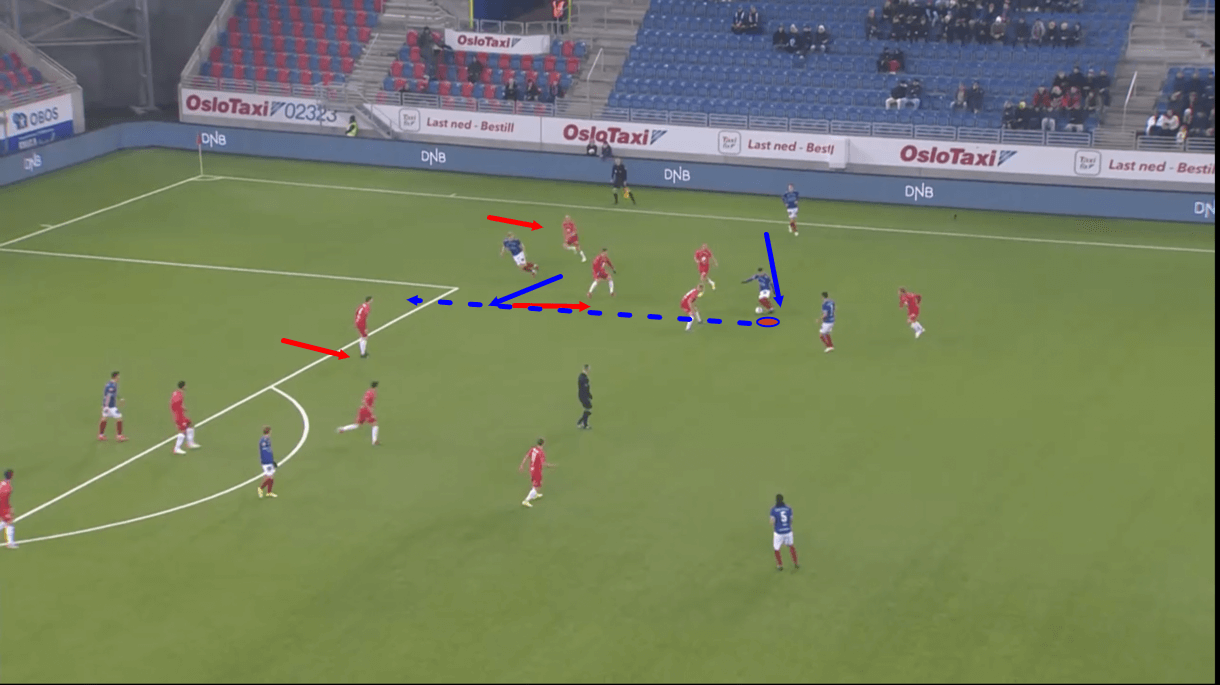
As Sahraoui carried the ball more centrally, it’s worth noting how this attracted pressure and manipulated the opposition’s defensive structure. Return to figure 9 and look at how the opposition were organised far better to prevent Sahraoui from splitting the defence. They were positioned deeper, with bodies in front of Sahraoui, essentially preventing any progression. However, moving on into figure 10, we can see that with Sahraoui having carried the ball more centrally, into the right half-space, he’s drawn the opposition’s backline further forward and attracted a couple of defenders directly to himself. This created space for his offensive teammate (running from the right wing on the corner of the box) to target and exploit via a diagonal run.
While still facing the centre, Sahraoui pulled off a disguised, defence-splitting through pass for his teammate running into the box diagonally from the right-wing. The disguised nature of this pass made it even more difficult for the opposition to anticipate and stop, while Sahraoui’s teammate timed his diagonal run targeting this newly-found space well. All of this led to the attacker being played in behind the opposition’s backline and a very dangerous goalscoring opportunity being created for Vålerenga.
This chance was created partly by the attacker’s intelligent movement, but primarily through Sahraoui’s ability to invade threatening space via his dribbling quality, keeping close control of the ball while moving into a more threatening position, attract pressure from opposition players while manipulating their defensive shape, his excellent vision to spot the through pass opportunity between a gap in the opposition’s shape as it opened up, and ultimately to execute his decision well and play his teammate through with an excellently-disguised through pass. This passage of play provides a perfect example of what makes Sahraoui so dangerous as a creative threat in the final third.
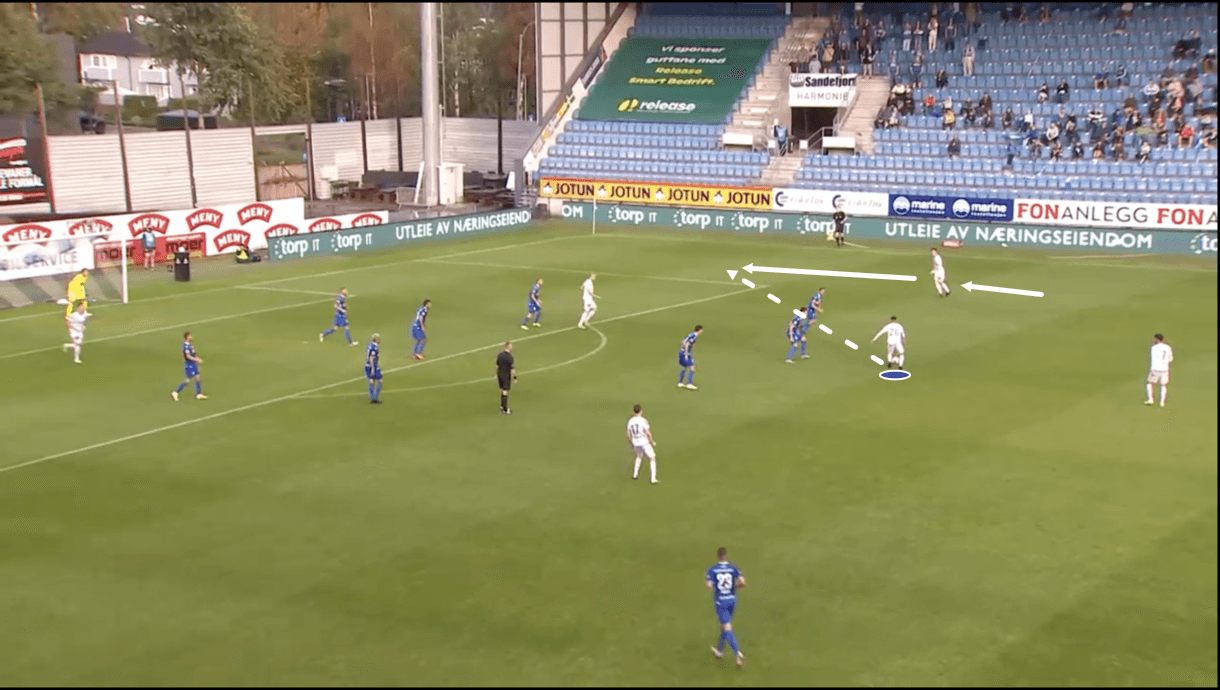
Another example of Sahraoui’s creative passing ability can be seen in figure 11. Here, the playmaker is positioned even more centrally, at a similar depth to where we saw him in figure 10. He spots a small gap opening between the opposition’s defensive shape as the wide midfielder pushes wider to try and mark the wide passing option and the central midfielder holds his ground to stand between Sahraoui and the goal. A small bit of space opening between these players is the only invitation Sahraoui needed to launch a defence-splitting through ball, which he managed to execute perfectly despite having such little margin for error. As play moves on, the Vålerenga wide man ends up in a dangerous crossing position and with a lot of space to work with.
This shows an example of Sahraoui’s risk-taking nature inside the final third. He could’ve easily just opted to send the ball out to the wide man to feet while keeping his team outside of the opposition’s defensive shape, but the 20-year-old was driven to push his team forward and instead chose to take the riskier passing option, sending the ball between defenders and getting his team in a dangerous crossing position. This is why Sahraoui is such an excellent creative asset in the final third and his teammates understand these progressive, attacking tendencies of his, reacting accordingly to his actions by being prepared to run forward, rather than expect a safer pass to feet. The Vålerenga man is very much the player you want on the ball to make things happen in the final third. He has a great combination of a risk-taking mentality along with the required technical quality to execute his vision.

Sahraoui is definitely more of a creator via through passes than he is a crosser. He typically prefers to occupy more central areas than wider areas and plays more defence-splitting ground passes than crosses. However, he does still play plenty of crosses — 2.3 per 90 this term, above average among the 90 wingers, attacking midfielders and centre-forwards to have played at least 500 Eliteserien minutes this season. What I like the most about Sahraoui’s crossing is his tendency to mix things up and use a large variety of different cross types, from different areas of the pitch. For example, in figure 12, we see Sahraoui crossing from the left half-space — the central position from where he likes to operate the most. From this area, we see him play a lot of inswinging crosses that can be very dangerous, requiring just a slight touch to be directed towards the net.
The 20-year-old is also comfortable with playing crosses from wider positions, using his excellent dribbling ability to create an opening for a cross. From wide, Sahraoui is comfortable with floating balls into the box and he’s capable of doing so without a lot of back-lift, meaning he can take advantage of openings to cross quite quickly after creating that opening via his dribble. Additionally, Sahraoui is able to mix things up by heading straight for the byline and drilling a low cutback cross into the box. Sometimes, the player’s decision-making is questionable when it comes to cross types but he can be dangerous from these situations, though not as dangerous as he’s proven to be with his through passes.
Shooting
Sahraoui is more of a creator than a scorer — you could probably draw that conclusion from his goals and assists numbers — but what about his shooting ability? Sahraoui’s two goals this season have come from 4.15 xG, while he managed to bag five goals in his debut Eliteserien campaign, so he’s clearly not completely alien to being in front of goal. He has demonstrated some excellent movement in the opposition penalty box to find himself in high-quality goalscoring positions. I think his off-the-ball movement in the opposition box is one of the attacker’s biggest strengths in terms of goalscoring.
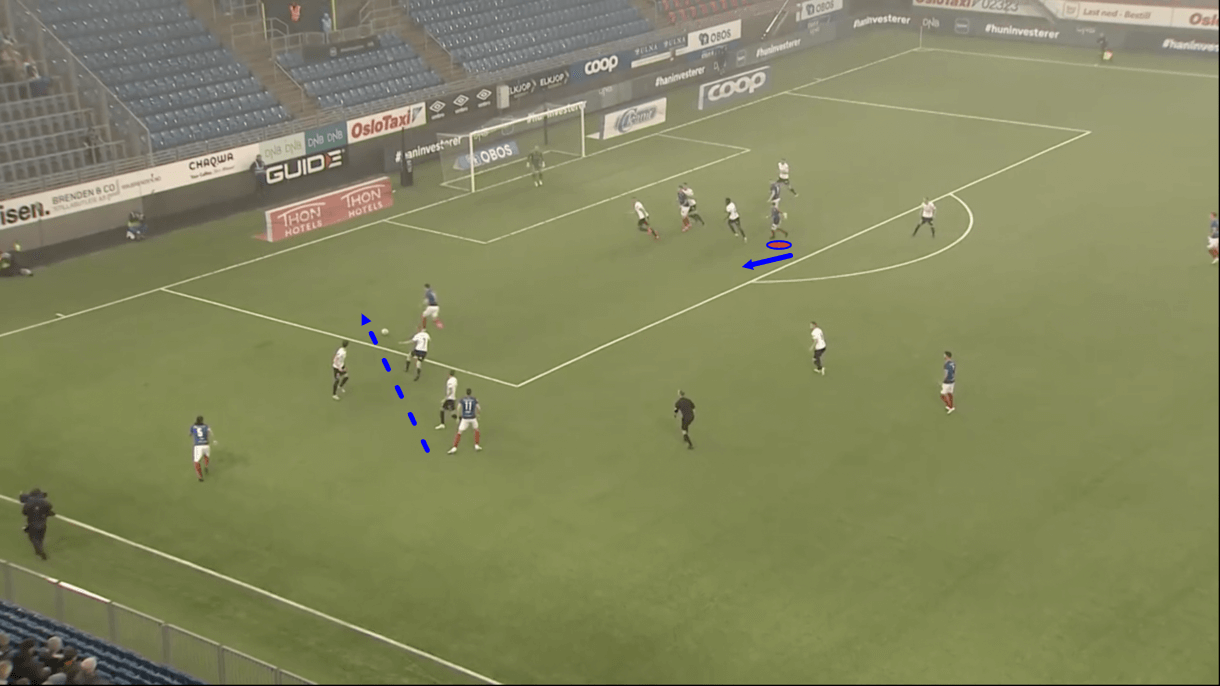
The passage of play in figures 13-14 highlights Sahraoui’s off-the-ball movement in the box and how devastating it can be. He’s really good at picking the right time to peel away from defenders and create some shooting space for himself in the penalty area. In figure 13, we see Vålerenga playing the ball into the box with a through pass directed towards the byline, with three Vålerenga attackers in the centre of the box for the potential crosser to aim for, including Sahraoui. However, the three attackers are outnumbered four-to-three by opposition defenders in the area. As the ball heads towards the byline, the opposition’s defenders are forced backwards to continue protecting their goal, and Sahraoui, aware of this, decides to move in a different direction to exploit space elsewhere while the opposition retreat, highlighting his impressive spatial awareness in the penalty area.
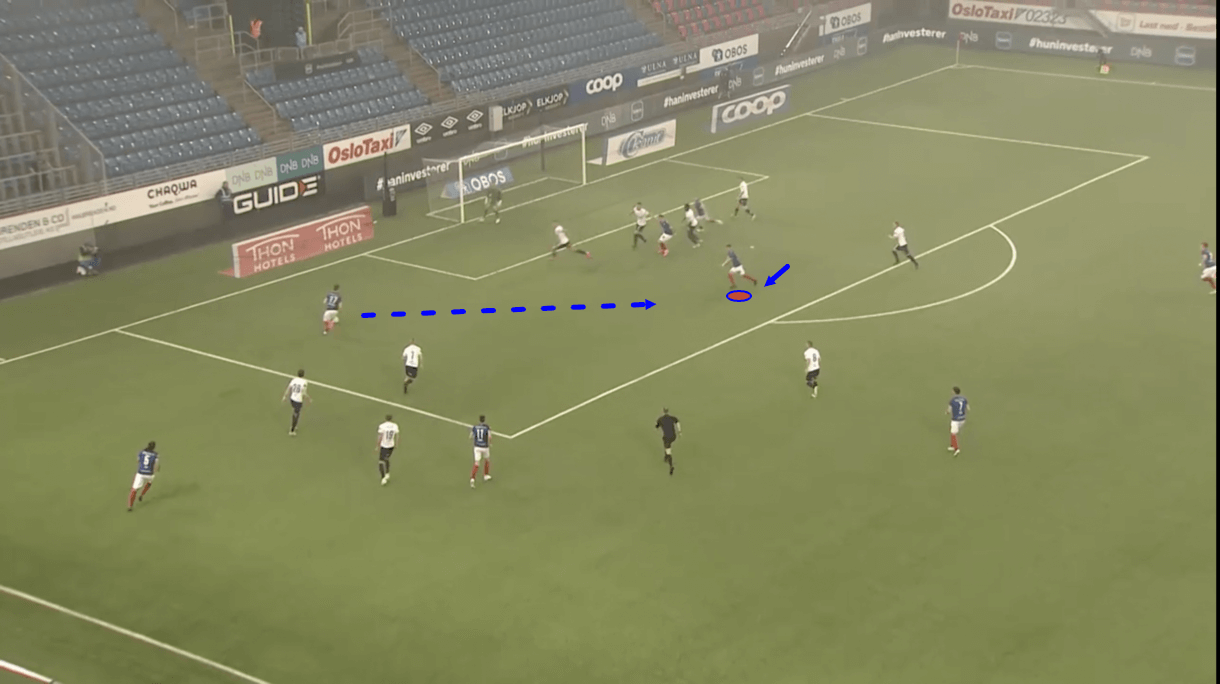
Sahraoui essentially slowed down and pulled slightly further away from the penalty spot to get away from the opposition defenders who were automatically drawn deeper, and this decision was rewarded. As play progressed into figure 14, we see that Sahraoui now had far more space than he enjoyed just seconds prior, and represented a good option for the crosser to pull the ball back to. This negated the opposition’s 4v3 advantage, as the Vålerenga man became a free body inside the penalty box.
The 20-year-old is typically very good at freeing himself up in the box like this thanks to his spatial awareness, vision to spot some free space inside the box, and ability to pull off subtle movements that exploit this space in a non-obvious way, allowing him to drift away from defenders. This movement helps him to get onto the end of plenty of cutback crosses like this one, which is a key part of his goal threat.
At the same time though, Sahraoui isn’t someone you might describe as a ‘natural finisher’. He’s not extremely comfortable in front of goal and allows decent goalscoring opportunities to go to waste sometimes, hence why he generally operates better just on the edge of the final third, supplying the players running in behind the last line and directly threatening the opposition’s goal.
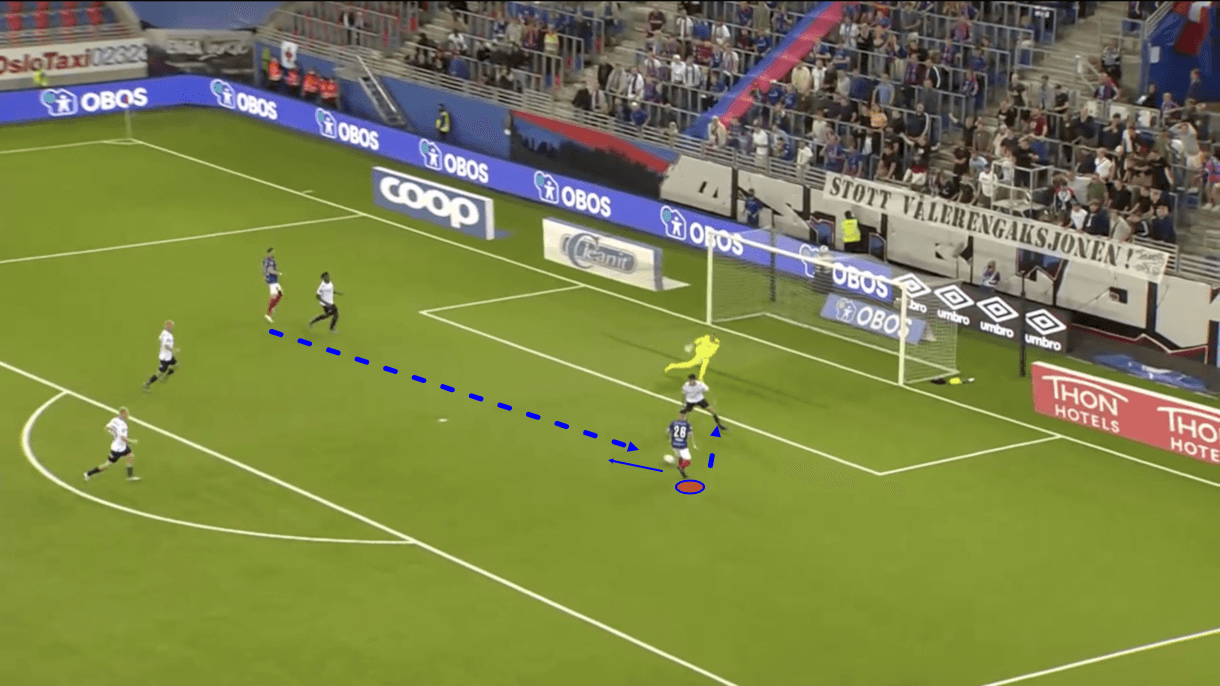
Sahraoui tends to snatch at goalscoring opportunities relatively often. He doesn’t take a large number of shots, in general (1.78 per 90 this season) but he also has a relatively poor shot accuracy rate (22.73%). His shot conversion rate of 4.545% is also very poor. He would do well to identify composure and decision-making in front of goal as potential areas of improvement. Figure 15 shows an example of one such situation when Sahraoui arguably lacked composure in front of goal. Just before this image, his Vålerenga teammate slid the ball nicely across the box into his path, with just one defender and the goalkeeper between Sahraoui and the goal. However, the attacker didn’t manage to beat the defender, firing the shot straight at him which resulted in the chance effectively going to waste.
One potential option Sahraoui had here was to take the ball back across goal, towards the centre, with the inside of his right foot, which could’ve wrong-footed the defender and ‘keeper while giving Sahraoui a shooting opportunity, in space, from a central position. This is a move that would’ve required some quick thinking and, most of all, a lot of composure, though. Instead, Sahraoui hit the ball as soon as it arrived at his right foot and without aiming for a corner, leading to the ball firing into the defender right in front of him.
This isn’t a rare occurrence and is something that you can argue is a major weakness in Sahraoui’s game in front of goal — he often has shots blocked, which may go some way to explaining his relatively poor conversion rate. Sahraoui’s shot selection can improve, as can his composure in front of goal. All of this arguably stems from his lack of comfortability in front of goal and tendency to snatch at chances.
Instead of shooting so urgently so often, maybe Sahraoui could work on trusting his ability on the ball more, even in these crucial situations, to forge out better opportunities than the ones he’s initially presented with. At present, too many of his shots go straight into the defenders in front of him, so regardless of what his solution is, this is a decision-making problem in his game that he can improve upon to take his contribution in front of goal up another level.
Defensive work
Sahraoui plays for the most aggressive pressing side in Norway’s top-flight at present and his defensive contribution reflects this. Firstly, there is still plenty of room for development in the defensive area of his game, especially in a physical sense but also technically and mentally. However, his application without the ball and work-rate are difficult to fault; the attacker offers a lot in these areas, which adds yet another key dimension to his game which would possibly make him an attractive option for clubs in other European leagues of higher standing, if the attacker is ready to test himself at another level and if clubs from those leagues are interested in acquiring his services. This isn’t to say he’s ready for PSG or Bayern Munich, but a lower-table Ligue 1 or Bundesliga side may be wise to consider him as an option.
This season, Sahraoui has made 5.37 successful defensive actions per 90, which is well above average for an attacker or attacking midfielder in Eliteserien. He’s engaged in 4.28 defensive duels per 90, which is relatively average, but he’s got a stellar 62.26% success rate, along with making a decent 2.26 interceptions per 90. Furthermore, Sahraoui doesn’t make a lot of fouls, with an average of 0.48 per 90. He isn’t one to dive into challenges on a whim, generally operating as a controlled, calculated character in defensive phases.
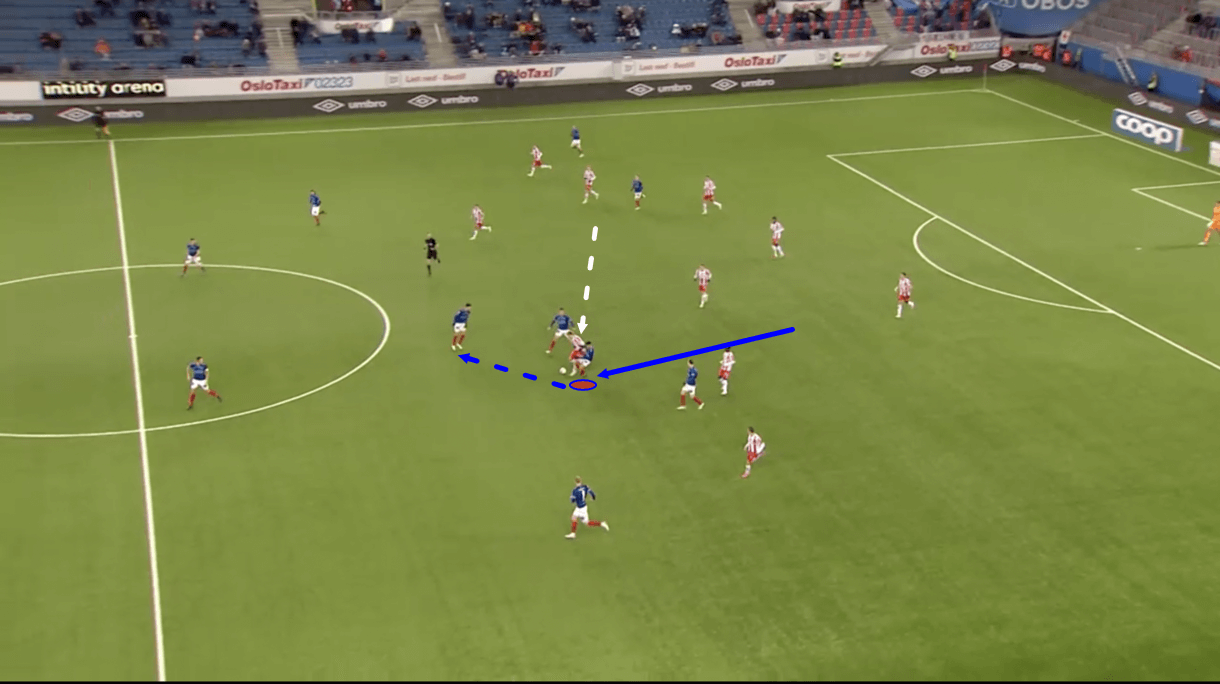
With Vålerenga typically being an aggressive side without the ball, Sahraoui is required to press from the front which he quite often does diligently and effectively. However, he’s generally even better when looking to recover the ball from a more advanced player who’s already progressed past him, as figure 16 shows. He’s an excellent asset for his side in counter-pressing, particularly when applying pressure from behind on a trapped opposition player.
This was the case in figure 16. Just before this image, Vålerenga were in possession but ended up getting dispossessed on their left wing. The opposition quickly sent the ball into the midfielder now in possession, but as he turned, Vålerenga’s counter-pressing structure came into action and trapped this player, preventing him from progressing quickly and easily. The ever-so-diligent Sahraoui, aware of the danger and his defensive duty, then tracked back to tackle the man on the ball, regaining possession for his side in the opposition’s half and turning this passage of play into a counter-attacking opportunity for his side instead.
The passage of play here highlights Sahraoui’s defensive awareness and work rate, as well as his technical tackling ability. He’s a hard-working player without the ball who’s happy to put a shift in to regain possession, while he also loves to perform the style of tackle we see in this example, where he’s neatly nicking the ball off the attacker’s foot, carefully yet effectively.
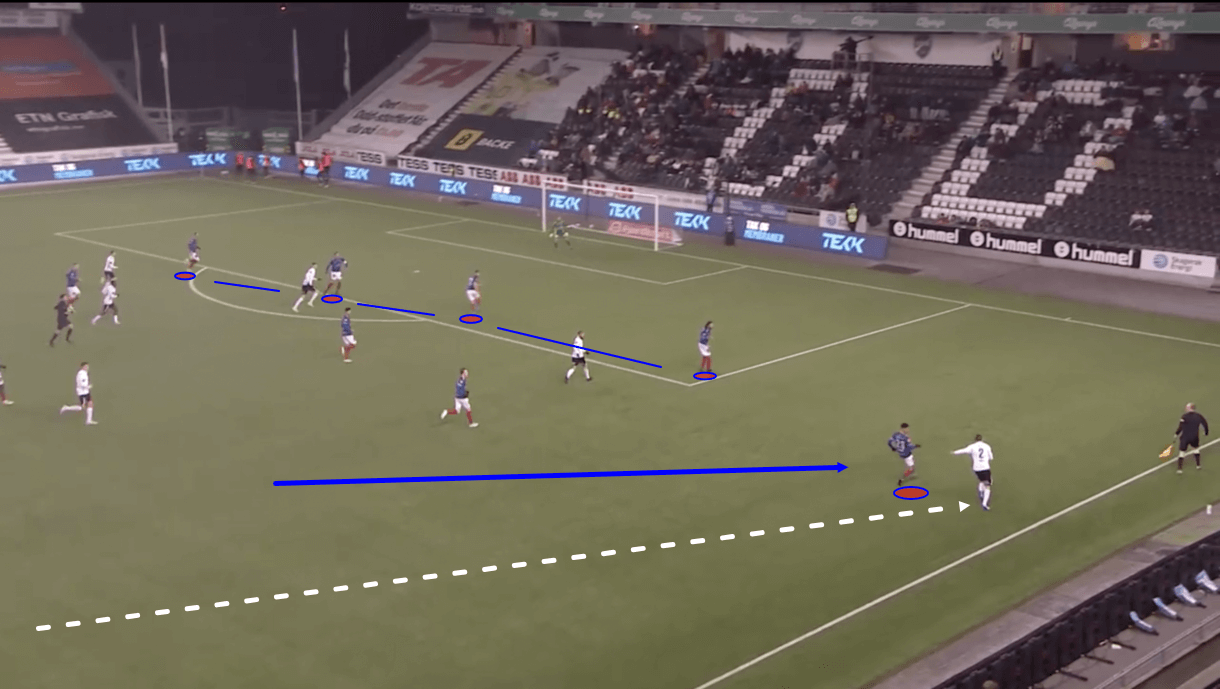
Meanwhile, figure 17 shows Sahraoui in a different defensive phase. Here, instead of counter-pressing, we see Vålerenga defending against the opposition in a more settled, deep defensive shape. Just before this image, Vålerenga were slightly higher but the opposition progressed the ball out to the wing, where Vålerenga left some space open, forcing Sahraoui’s team to retreat.
In this example, we see Sahraoui performing his defensive duties during this low-block phase excellently. On seeing the ball get played past him out wide, he sprung into action to close down the receiver and prevent him from exploiting the space his side has left open on the wing. This shows his solid work rate and a good understanding of his tactical role in this phase — as the left-winger in this game, he was required to close down the opposition’s wide man on the right when he ended up on the ball, and the Vålerenga man performed this role perfectly here.
As well as closing the ball-carrier’s space, Sahraoui’s application to his defensive duties allowed his team’s back-four to remain tight, deep and compact, preventing the opposition from creating space centrally with this ball out to the right wing. Had Sahraoui not tracked back so quickly and effectively here, either the wide man would enjoy way too much space or Vålerenga’s left-back would’ve been dragged out wide. However, thanks to Sahraoui, the wide man was closed down and Vålerenga’s back-four could remain together, keeping Vålerenga’s structure essentially as difficult as possible to break down.
Conclusion
To conclude this tactical analysis and scout report, I feel Sahraoui is an excellent playmaker and while he’s still young and malleable, as stated at the beginning of this analysis, I feel he’s best used as a creative attacker on either the left-wing or as a ‘10’. This is clearly where he’s most comfortable at present and where he tends to operate the best.
Sahraoui’s big strengths lie in his dribbling and creative passing ability just on the edge of the final third, meanwhile, he can improve his quality in deeper areas, particularly in some mental aspects, and in front of goal. Defensively, Sahraoui can develop in the key areas mentioned in that section, but he’s definitely a big asset for his team in these phases as well thanks to his defensive diligence and awareness.

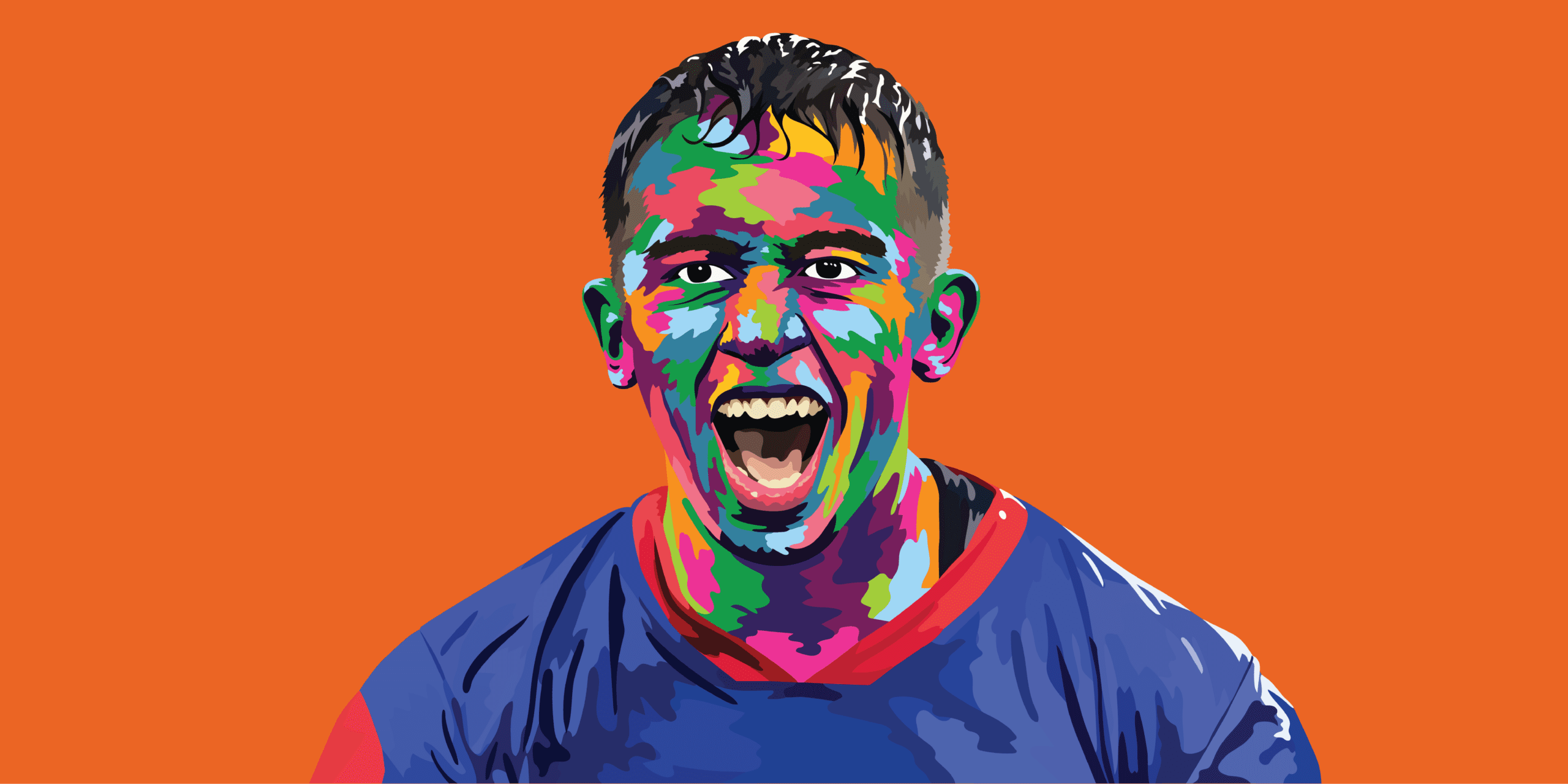



Comments